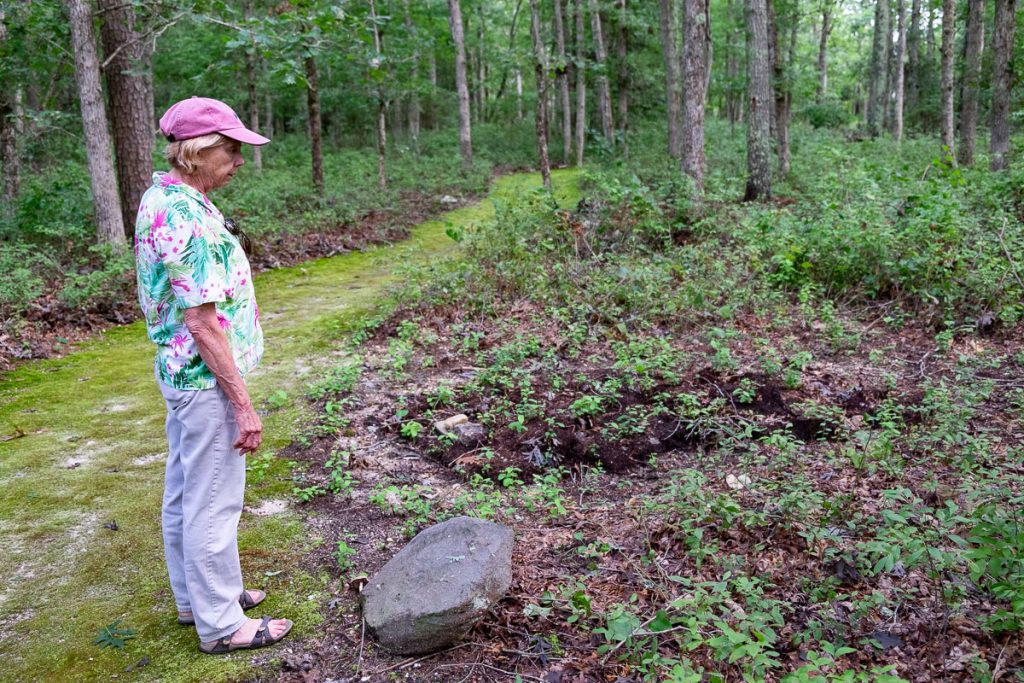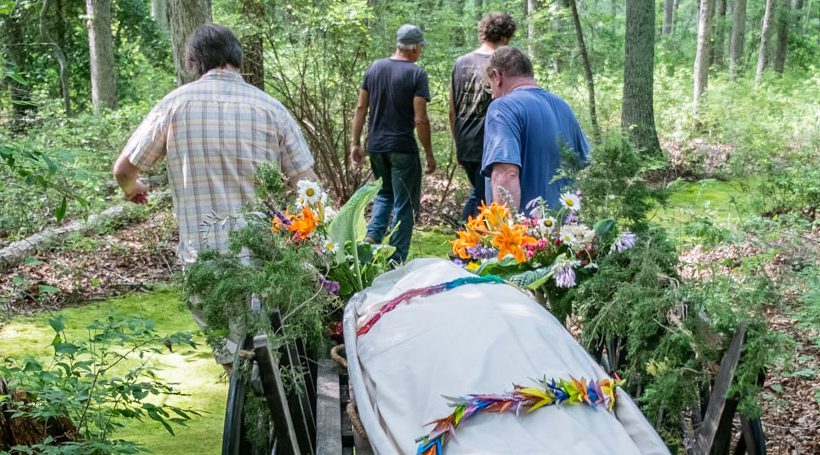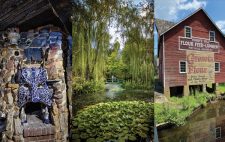Photos: Tom Bailey
Ed Hoffner and his wife Dorothea are buried just beyond a curve in a moss-covered path in the most eco-friendly of settings. Their graves, marked with rough stones and grown over with wild highbush blueberries, can be found in Steelmantown Cemetery, a 9-acre resting ground tucked between cranberry bogs in Cape May County. Belleplain State Park is just to the west and the Cape May National Wildlife Refuge sits to the east.
Steelmantown, where the Hoffners received a natural burial – first Ed in 2016, then Dorothea this summer – is known as a green cemetery. To prepare for an organic return to the earth, their bodies were wrapped in muslin shrouds and then lowered into a hand-dug grave in the soil. It was a no-brainer that their funerals would be handled this way: their daughter, Ann Hoffner, literally wrote the book on the practice. Her “Natural Burial Cemetery Guide,” now in its second edition, is a comprehensive list of cemeteries around the country that meet the standards to be called a natural cemetery, with no vaults or embalmed bodies, and biodegradable coffins.
“It’s intended to involve people,” Hoffner says. “It’s the family doing the burying, and it gets them talking about death and caring for their loved one themselves.”
This was the way of burial until the Civil War era, when embalming grew in popularity. Even today, many religious and cultural traditions continue to practice their own form of green burials. Both traditional Jewish and Muslim customs call for the body to be wrapped in a shroud and buried as soon as possible following death.
Steelmantown Cemetery has been on the natural cemetery list since 2007, when its owner Ed Bixby acquired it in an unusual way.
“My family came to America in 1680, and established our family burial ground at Steelmantown in the 1700s,” he says.
In its day, it was a bustling spot with a schoolhouse and a chapel. But by the time Bixby’s infant brother was buried there in 1957, the schoolhouse was gone, the chapel was deteriorating and the cemetery was in disarray.
“It became more hidden,” Bixby says, “because the forest around it grew, and nobody knew it was there.”
By the time he went back to visit in the early 2000s, it had become a dumping ground. So Bixby, a real estate developer, tracked down the local man who owned the grounds to complain about the cemetery’s conditions.
“He said, ‘how about I give you the cemetery,’” Bixby recalls. “It seemed like a strange proposition, but I thought, ‘Well, somebody has to take care of it.’ There are generations of my family buried there.”
He cleaned up the property, removing 20 truckloads of debris and garbage, and thought that was as involved as he’d be with the cemetery. Then he read an article on natural burial. “It basically said to become a natural burial ground, you had to have a place that had never practiced conventional burial. This was a place that time forgot, so it never had vaults, nobody got embalmed,” Bixby says. “I thought, well, we meet all the requirements.”
In 2007, Steelmantown Cemetery became one of just a handful of natural burial sites recognized by the Green Burial Council. Bixby didn’t do much marketing, but people began to find him and his cemetery.
“I buried my first person in the spring of 2008,” he says. “That year I probably had like half a dozen people.”
The numbers rose steadily. Now, he says, he’s interring 35 to 40 bodies each year. The number of people buying plots to be used for a later date is triple that.
At first, Bixby says, he thought it was just about doing something environmentally friendly. But after the first few funerals, he realized it was something deeper.
Families began flying in with their deceased from around the country to hold funerals at Steelmantown, and for good reason: “It’s magical,” Hoffner says. “These moss-covered winding trails give it a Disneyland-type feeling. You walk into the woods and wind around and you get lost, and it’s just so beautiful and peaceful.”
It’s a place, both Hoffner and Bixby say, that feels – perhaps a bit ironically – full of life. When she buried her father there in 2016, Hoffner realized she “wasn’t worried about leaving him, because I knew he wasn’t alone.” She felt that the other organisms in the ecosystem, from the bugs to the roots of the trees, would keep him company. The point was driven home for her when, during his graveside ceremony, a butterfly flitted around the grave and her father’s body.
This summer, she says, when the family buried Dorothea next to her husband, “one butterfly came out, and then another came out and joined it,” Hoffner says. “It was like my father came and collected my mother and they went off dancing through the forest.”

Ann Hoffner visits her parents’ burial site
The fairytale forest surroundings of Steelmantown bring people a lot of peace and healing, says Bixby, but not everyone envisions their final resting place in the woods. He’s started offering families another kind of natural resting place – a kind of burial at sea. One option involves a scattering of cremated remains at a picturesque spot in the Tuckahoe River.
Ashes can also be mixed with concrete to form spheres known as reef balls. Bixby sails mourners out to environmentally approved locations at sea where they can sink the balls to serve as an artificial reef. These undersea memorials support marine life by increasing biomass and marine nourishing areas that have been impacted by climate change, pollutants and overfishing, Bixby says.
“The one thing you have to understand,” he adds, “is that for a lot of families, this is all a little outside the box.”
People have grown accustomed to orderly cemeteries with concrete vaults and Astroturf grave coverings, he says. But natural burials are more intimate and, in his experience, more healing for the grieving family. Plus, of course, it’s one last way to go green.
“Natural burial is certainly good for the earth,” Bixby says, “but it’s even better for the soul.”














